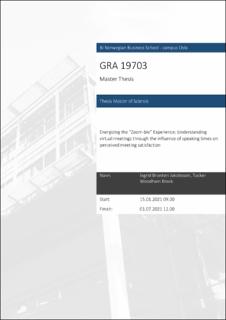| dc.description.abstract | In this study, our objective was three-fold. Firstly, we wanted to better
understand virtual meetings through the influence of meeting participation (i.e.,
meeting energy and meeting engagement) on perceived meeting satisfaction. In
this respect, we hypothesized that meeting energy and meeting engagement would
each positively relate to meeting satisfaction. Secondly, we tried to discover the
effects of meeting size, meeting length, and meeting leader presence, respectively,
on meeting participation. For these meeting factors, we assumed that each would
bear negative relationships with our meeting participation constructs. Lastly, we
sought to find a negative relationship between meeting size and perceived meeting
satisfaction, as well as a negative relationship between meeting length and
perceived meeting satisfaction.
To analyze these relationships, we collected 23 virtual meeting recordings
from five different organizations. In addition, we had each meeting participant
answer a survey measuring perceived meeting satisfaction shortly after each
meeting was held. We then incorporated speech analysis software (i.e., ELAN
6.0) in order to measure the speaking time of each meeting participant. Overall,
our results confirmed several of our hypotheses: meeting size, meeting length, and
meeting leader presence each shared a negative relationship with both meeting
energy and meeting engagement. In addition, meeting size, as we anticipated, was
shown to have a direct, negative relationship with meeting satisfaction. However,
we failed to notice a significant relationship between meeting length and meeting
satisfaction, or a significant relationship between meeting energy and meeting
satisfaction. Lastly, and opposite to what we intended to find, our results showed a
direct, negative relationship between meeting engagement and meeting
satisfaction.
This study adds to the existing literature on the developing field of
meeting science by emphasizing the concept of participation within virtual
meetings and its worthwhile relationship with meeting satisfaction. Theoretical
and practical implications of the findings are discussed. | en_US |
